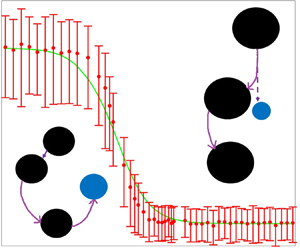Article contents
Collision rate of bidisperse, hydrodynamically interacting spheres settling in a turbulent flow
Published online by Cambridge University Press: 04 February 2021
Abstract

The collisions in a dilute polydisperse suspension of sub-Kolmogorov spheres with negligible inertia settling in a turbulent flow and interacting through hydrodynamics including continuum breakdown on close approach are studied. A statistically significant decrease in ideal collision rate without gravity is resolved via a Lagrangian stochastic velocity-gradient model at Taylor microscale Reynolds number larger than those accessible by current direct numerical simulation capabilities. This arises from the difference between the mean inward velocity and the root-mean-square particle relative velocity. Differential sedimentation, comparable to the turbulent shear relative velocity, but minimally influencing the sampling of the velocity gradient, diminishes the Reynolds number dependence and enhances the ideal collision rate i.e. the rate without interactions. The collision rate is retarded by hydrodynamic interactions between sphere pairs and is governed by non-continuum lubrication as well as full continuum hydrodynamic interactions at larger separations. The collision efficiency (ratio of actual to ideal collision rate) depends on the relative strength of differential sedimentation and turbulent shear, the size ratio of the interacting spheres and the Knudsen number (defined as the ratio of the mean-free path of the gas to the mean radius of the interacting spheres). We develop an analytical approximation to concisely report computed results across the parameter space. This accurate closed form expression could be a critical component in computing the evolution of the size distribution in applications such as water droplets in clouds or commercially valuable products in industrial aggregators.
- Type
- JFM Papers
- Information
- Copyright
- © The Author(s), 2021. Published by Cambridge University Press
References
REFERENCES
- 11
- Cited by





